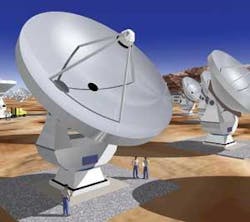By Ben Ames
SCOTTSDALE, Ariz. - When defense contractors build optical instruments, they are usually designed for battlefield surveillance, yet some of the planet’s most powerful telescopes point away from Earth.
Astronomy officials in July awarded a $169 million contract to General Dynamics C4 Systems in Scottsdale, Ariz., for 25, 12-meter antennas in the planned ALMA millimeter-wavelength radiotelescope, to be built on a Chilean peak by 2012.
Other contractors are earning business for space-based telescopes. Engineers at Northrop Grumman have tested software that will align the mirrors on the James Webb Space Telescope, part of an $825 million contract to launch the craft by 2011.
An even bigger project, the Thirty-Meter Telescope, is still in the planning stages. It is run through the National Optical Astronomy Observatory in Tucson, Ariz., an office of the Association of Universities for Research in Astronomy in Washington. For more information, see www.aura-nio.noao.edu.
ALMA will include an array of 64 telescopes, each 12-meters across, located at Chajnantor, a 15,000-foot mountaintop in Chile. This artist’s drawing shows three people for scale.
Astronomers use a combination of land- and space-based instruments to manage the design tradeoffs. Space-based instruments can see the stars without squinting through Earth’s atmosphere, although their mirrors must be small enough to fit on a launch rocket. Earth-based instruments have enormous mirrors, but they must use technology such as adaptive optics to compensate for atmospheric blurring.
Astronomers from around the world will use the Atacama Large Millimeter Array (ALMA) telescope to see galaxies out to the edge of the universe, and stars and planets in their formative stages.
As an international collaborative effort to build the world’s most sensitive millimeter and submillimeter wavelength telescope, ALMA ultimately could consist of an array of as many as 64 antennas, and an additional compact array from Japan, all in Chile’s Atacama Desert-16,500 feet above sea level.
Networked together with high-bandwidth signal processing, the array will act as a single instrument to observe the enigmatic cold regions of the universe, which are optically dark, yet shine brightly in the millimeter portion of the electromagnetic spectrum. Working together, the antennas will provide spatial resolution 10 times sharper than the Hubble Space Telescope.
“Imaging qualities and the ability to change the configuration of the antennas will make ALMA astronomy’s most versatile imaging instrument,” says Gary Kanipe, the General Dynamics C4 Systems vice president responsible for the program. “General Dynamics has reached an unprecedented level of radio telescope sophistication as evidenced by the decision to award the ALMA contract.”
Millimeter and submillimeter-wave astronomy studies the universe in the spectral region between what is traditionally considered radio waves and infrared radiation. In this realm, ALMA will study the structure of the early universe and the evolution of galaxies; gather crucial data on the formation of stars and planets; and provide new insights on our own solar system.
The James Webb Space Telescope’s 6.5-meter primary mirror will be composed of 18 hexagonal segments, all protected from the sun with a large shield, as shown in this artist’s drawing.
The first antenna is scheduled for delivery in 2007 with final delivery of all the antennas expected by the end of 2011. Pre-assembly work on the contract will take place at the General Dynamics C4 Systems Kilgore, Texas, and Duisburg, Germany, facilities.
In February 2000 Vertex Antenna Systems won a contract to build one of two antenna prototypes. General Dynamics took over this business in September 2004.
ALMA construction and operations are led on behalf of North America by the National Radio Astronomy Observatory (NRAO), operated by Associated Universities Inc. in Washington (AUI) for the National Science Foundation.
ALMA is a partnership between North America (the United States and Canada), Europe, and Japan, in cooperation with the Republic of Chile. The NRAO received funding for ALMA in North America from the U.S. National Science Foundation in cooperation with the National Research Council of Canada. For more information, see www.mma.nrao.edu.
In contrast, engineers with Northrop Grumman Space Technology in Redondo Beach, Calif., face a much different challenge in creating the James Webb Space Telescope (JWST).
Their software must order the observatory’s 18 mirror segments into precise alignment following the rough vibrations and disturbances of their launch.
Together, those segments will form a 6.5-meter mirror with 10 times the light-gathering capabilities of Hubble. It will be able to see objects 400 times fainter than those currently studied with ground telescopes as it hovers at the L2 Lagrange point, 1.5 million kilometers from Earth.
Northrop Grumman software technicians tested the accuracy of the coarse-phasing (or rough-focusing) mode developed for JWST’s Wavefront Sensing and Control System (WFS&C) during an exercise June 18 at the Keck Observatory in Hawaii.
The team chose that location because the Keck’s twin 10-meter telescopes, like JWST, feature large, actively controlled, segmented, hexagonal mirrors.
“Actively controlled segmented mirrors are the industry standard for large ground-based telescopes, but JWST will be the first space observatory to use deployable, active segmented mirrors,” says Martin Mohan, JWST program manager at Northrop Grumman Space Technology. “The success of this test gives us confidence that we’ll be able to adjust the telescope to meet the mission’s stringent science objectives.”
The test was conducted by Northrop Grumman’s teammate, Ball Aerospace & Technologies, Boulder, Colo., along with NASA’s Jet Propulsion Laboratory, Pasadena, Calif., using prototype hardware and flight software developed by Adaptive Optics Associates, Cambridge, Mass. For more information, see http://ngst.gsfc.nasa.gov.
“This test is an excellent example of collaboration between space and ground-based astronomy programs to extend and improve the technology use in WFS&C for large telescopes,” says Paul Lightsey, JWST chief system engineer at Ball Aerospace & Technologies.


